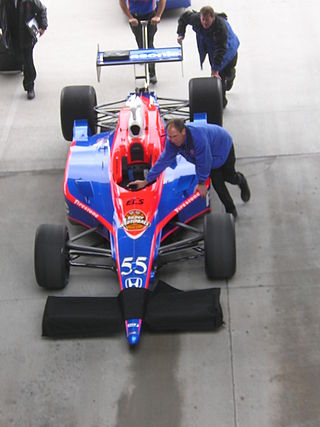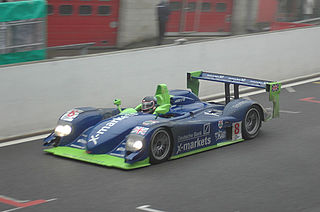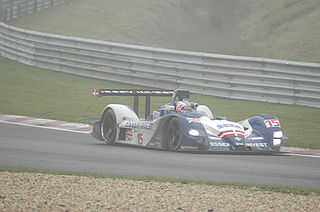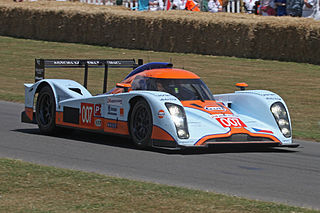Lola Cars International Ltd. was a British race car engineering company in operation from 1958 to 2012. The company was founded by Eric Broadley in Bromley, England, before moving to new premises in Slough, Buckinghamshire and finally Huntingdon, Cambridgeshire, and endured for more than fifty years to become one of the oldest and largest manufacturers of racing cars in the world. Lola Cars started by building small front-engined sports cars, and branched out into Formula Junior cars before diversifying into a wider range of sporting vehicles.

Judd is a brand of racing car engines built by Engine Developments Ltd., a company founded in 1971 by John Judd and Jack Brabham in Rugby, Warwickshire, England. Engine Developments was intended to build engines for Brabham's racing efforts, and became one of the first firms authorised by Cosworth to maintain and rebuild its DFV engines, but has since expanded into various areas of motorsport.

Fernández Racing was a Mexican motor racing team that competed in the American Le Mans Series, Champ Car, the IRL IndyCar Series, and the Rolex Sports Car Series. The team was co-founded by Adrian Fernández and Tom Anderson in 2001.
The 2006 American Le Mans Series season was the 36th season for the IMSA GT Championship, with the eighth as the American Le Mans Series. It was a series for Le Mans Prototypes (LMP) and Grand Touring (GT) race cars divided into 4 classes: LMP1, LMP2, GT1, and GT2. It began March 18, 2006, and ended October 21, 2006 after 10 races.
Advanced Engine Research, Ltd. is an auto racing engine manufacturer based in Basildon, Essex, England. Established in 1997, AER has developed winning engines for a number of high-profile international race series in sports car, prototype racing, rallying, touring car, and open wheel racing. They have designed engines derived from road car platforms, but their emphasis is on clean sheet designed engines with a focus on electronics and turbochargers. Their engines have raced in the 24 Hours of Le Mans, the World Endurance Championship (WEC), the European Le Mans Series (ELMS), the United SportsCar Championship (TUSC), GP3, British Touring Car Championship (BTCC), Nissan/Renault World Series, Grand-Am, Paris Dakar and FIA Sportscar Championship. They have worked with a number of manufacturers including Mazda, Ford, Hyundai, MG/Rover, Nissan, and Toyota. In 2012, AER developed and built Formula One turbo test engines to current rules and in July 2012, AER was chosen as engine partner and supplier to the new GP3 racing series. They currently supply engines for the Indy Lights series.

The Acura ARX-01, later known as the HPD ARX-01 is a series of Le Mans Prototype built for sports car racing, specifically in the American Le Mans Series, Le Mans Series, and at the 24 Hours of Le Mans. It is the first purpose-built race car by the Acura division of Honda Motor Company, part of their multi-year program to eventually compete in endurance race. The car debuted in 2007 in the American Le mans Series before expanding to customers in Europe. Over the years various specifications of the ARX-01 chassis have been developed, each signified by a letter suffix. In 2010 Acura withdrew their name from the program and Honda Performance Development which developed the car for Acura continued the program into 2011.

Creation Autosportif, Ltd. was a sports car racing team based in Oxford, England. It was founded in 2003 by Ian Bickerton and Mike Jankowski and has raced in the FIA GT Championship, FFSA GT Championship, American Le Mans Series, Le Mans Endurance Series, as well as the 24 Hours of Le Mans. Their cars are known for their blue and yellow paint schemes.

The Dallara SP1, also known as the Chrysler LMP, was a Le Mans Prototype built by Italian firm Dallara. Initially used as part of Chrysler Corporation's attempt to win the 24 Hours of Le Mans, the cars were later sold to customers for use series such as the FIA Sportscar Championship and Le Mans Series.

The MG-Lola EX257 is a Le Mans Prototype built by Lola for the MG car company for their attempt to compete again at the 24 Hours of Le Mans in 2001. The car has had many years of mixed success since its introduction, even in privateer hands.

The Lola B98/10 was a Le Mans Prototype built by Lola Cars International for use in the International Sports Racing Series, American Le Mans Series, and 24 Hours of Le Mans. It would be the first international sports car built by Lola since they briefly left the sport in 1992 following the Lola T92/10. It would be succeeded in 2000 by the Lola B2K/10.

The Lola B2K/10 was a Le Mans Prototype developed in 2000 by Lola Cars International for use in the 24 Hours of Le Mans, American Le Mans Series, Grand American Road Racing Championship, and Sports Racing World Cup. It was a replacement for the previous Lola B98/10 and shared some elements with its smaller variant, the Lola B2K/40.

The Lola B2K/40 was a Le Mans Prototype developed in 2000 by Lola Cars International as a cheaper, smaller, and lighter alternative to the similar Lola B2K/10. Although specifically designed to compete in the SR2 class of the Sports Racing World Cup and Grand American Road Racing Championship, it would later be adapted to the LMP675 and LMP2 classes for the 24 Hours of Le Mans and American Le Mans Series. This design was replaced in 2005 by the Lola B05/40 and would last be used in competition in 2006.

The Lola B05/40 is a Le Mans Prototype built by Lola Cars International for use in the LMP2 class for the American Le Mans Series, Le Mans Series, and 24 Hours of Le Mans. Developed in 2005, it was intended as a replacement for both the Lola B2K/40 and the MG-Lola EX257. It shares various structural elements with the larger LMP1-class Lola B06/10.

The Lola B08/60 is a Le Mans Prototype built by Lola Cars International. It is the first closed-cockpit sports prototype built by Lola since the 1992 T92/10. It started competition in 2008, with Aston Martin being among the first customers for their entry into the LMP1 category in Le Mans Series, albeit entering under Charouz Racing System banner.

The Panoz LMP-1 Roadster-S was a Le Mans Prototype built for Panoz in 1999. The car was a successor to the Esperante GTR-1 which had competed in the Grand Tourer categories internationally. Following competition in the American Le Mans Series and at the 24 Hours of Le Mans until 2001, the car was replaced by the Panoz LMP07.

The Reynard 02S was a Le Mans Prototype race car built by Reynard Motorsport in 2002. Intended to replace the failed Reynard 2KQ prototype, the 02S would end up becoming the final new design from Reynard as the company went bankrupt prior to the project's completion.
The 2008 Le Mans Series was the fifth season of ACO's Le Mans Series. It was a series for Le Mans Prototype and Grand Touring style cars broken into 4 classes: LMP1, LMP2, GT1, and GT2. It ran from 6 April to 14 September 2008 with five rounds taking place.

The Lola-Aston Martin B09/60, also known as the Aston Martin DBR1-2, is a Le Mans Prototype sports car built by Lola Cars International and co-developed with Prodrive for use by Aston Martin Racing. It is the first prototype to bear the Aston Martin name since the AMR1 in 1989. Aston Martin's internal name for the car, DBR1-2, refers to the specific DBR1 chassis which won six races in 1959 en route to clinching the World Sportscar Championship as well as that year's 24 Hours of Le Mans.

Champion Racing was a sports car racing team based in Pompano Beach, Florida, USA. Founded in 1994 by Dave Maraj, a former rally driver from Trinidad, as the motorsport wing of the Champion Motors car dealership, the team has campaigned various Porsches and Audis in North American road racing series. Champion Racing's extensive record includes a win at the prestigious 24 Hours of Le Mans in 2005, and 5 straight American Le Mans Series LMP1 championships, 2 as a private team and 3 as a factory team under the name Audi Sport North America.
Intersport Racing is a former American auto racing team founded by Jon Field. The team was based in Dublin, Ohio. They previously operated two Oreca FLM09 sports cars in the American Le Mans Series. At current, the company has transitioned into diet supplements.
















